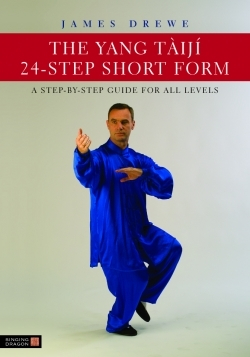The Yang Taiji 24-Step Short Form
Step-By-Step Guide For All Levels
Taiji (Tai Chi), a dance-like combination of moving meditation and martial art, serves as a kind of bridge between the mind and the soul, according to author James Drewe. He began learning Chinese martial arts in 1975 and is currently vice-chairman of the Longfei Taijiquan Association.
The 24-step short form of taiji came into being in 1956 “…to make taiji more accessible to a wider range of people.” This comprehensive book maps out in scrupulous detail, supported by nearly 700 photographs plus drawings, all the moves (hands, feet, legs, torso, musculoskeletal system, breathing, and more) for each of the twenty-four forms. Each form includes instructions for beginners as well as for more advanced practitioners.
Before getting to extensive how-tos of the forms, the author covers basics that include warming up, posture, alignment, breathing, grounding, correct positioning to protect the knees, stances, legs, and footwork. Sections discuss taiji’s uses for relaxation, release, health, and self- defense. In regards to health, for example, the author likens the body’s systems to hosepipes; bends in the hose block the flow of the body’s work. He notes, “Taiji is a method of understanding relaxation and of learning how to control it so that the body can open out/release and undo, enabling the systems of the body…to function unimpaired.”
The twenty-four forms—with names like “Stork Spreads its Wings” and “Grasp the Bird’s Tail”—are explained with extensive photo illustrations, brief thumbnail descriptions, details about hand rotation, notes to understand the energetic flow of the movements, and other more advanced information. For quick reference, there’s a summary section with all the footprint patterns for all of the forms and an “easy reference section” with form names and photographs only. These features will be convenient for readers who want to use the book for guidance as they practice the forms.
The “Beyond the Basics” section offers insights into practicing taiji in competition, working with a partner, connecting with the body, energetic opening and closing movements, and more detailed illustrations which describe the subtleties of various positions.
While some students may learn better with video, the author has done an admirable job, given the challenges of presenting instructions for movement in words and still photos. His passion for sharing this accessible version of taiji is evident throughout the text. With words of wisdom, complemented by years of experience and perspective as teacher, Drewe draws forth the subtleties of the “feeling” (of the moves), helping students access a deeper embodiment of the forms—truly bridging mind and soul through this mindful movement practice.
Reviewed by
Bobbye Middendorf
Disclosure: This article is not an endorsement, but a review. The publisher of this book provided free copies of the book and paid a small fee to have their book reviewed by a professional reviewer. Foreword Reviews and Clarion Reviews make no guarantee that the publisher will receive a positive review. Foreword Magazine, Inc. is disclosing this in accordance with the Federal Trade Commission’s 16 CFR, Part 255.

